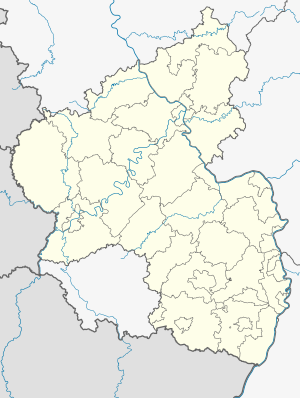Insheim geothermal power plant
| Insheim geothermal power plant | |||
|---|---|---|---|
| Deep drilling (2009) | |||
| location | |||
|
|
|||
| Coordinates | 49 ° 9 '14 " N , 8 ° 9' 12" E | ||
| country |
|
||
| Data | |||
| Type | Geothermal ORC power plant with deep drilling | ||
| Primary energy | Geothermal energy | ||
| power | 4.8 MW electrical 6-10 MW thermal (optional) |
||
| operator | Pfalzwerke geofuture | ||
| Start of operations | 2012 | ||
| Website | www.geothermie-insheim.de | ||
The Insheim geothermal power plant is a geothermal power plant in the southern Palatinate town of Insheim . The plant has been operated by Pfalzwerke geofuture GmbH since November 2012 . The system converts thermal energy from the deep water into electricity.
Location
The conditions in Insheim are particularly favorable for the extraction of geothermal energy due to the geological situation in the Upper Rhine Graben , with water temperatures of more than 160 degrees Celsius at a depth of around 4000 meters.
Investigations and analyzes in advance led to the selection of the location between the town of Insheim and the A 65 motorway . From 2008 to 2012, two boreholes were sunk and the complete power plant installation was carried out.
Power plant operation
The electricity is generated by an ORC system, which transfers the energy to a turbine using the carrier medium isopentane .
The process used in the geothermal plant in Insheim uses the heat from the thermal water, which is pumped through deep boreholes and cooled back into the ground through reinjection boreholes. Due to insufficient discovery, a side arm (sidetrack) was drilled to improve the hydraulic properties, but the original borehole was not filled, so that a borehole with two arms is now available for reinjection. With such a deflection hole, the water can be distributed more quickly and more spaciously underground. This means that less pressure is required during operation. There are regular earthquakes around the facility , up to June 19, 2020, 154 quakes were registered directly below Insheim, the maximum magnitude was 2.4. In the area around the plant there are more earthquakes that are not always directly under Insheim, but are caused by the operation of the power plant. On May 20, 2020, an earthquake with a magnitude of around 2.2 was registered.
Project progress
The following table shows the history of the project:
| Period | Project step |
|---|---|
| As of February 2007 | Planning and preparation |
| From November 2007 | Start of drilling site work |
| June 2008 to September 2008 | Execution of the first deep borehole |
| January 2009 to April 2009 | Implementation of the second deep borehole |
| April and November 2009, March to April 2010 | Circulation tests, checking the flow rates and temperature of the thermal water |
| April 9, 2010 10:52:22 am | The strongest earthquake registered in Insheim with a magnitude of 2.4. |
| August 2010 to October 2010 | Drilling of another side arm |
| From October 2010 | Preparations for construction work, building permits, planning the power plant |
| September 2011 to October 2012 | Construction of the transmission part |
| October 2012 | First commissioning of the power plant |
| November 2012 | Start of power plant operation |
| February 2013 | Business interruption after pump damage |
| May 2013 | Recommissioning |
Key figures of the geothermal power plant
Key figures of the plant:
- Thermal water temperature: 160–165 ° C,
- Flow rate: 50–80 l / s,
- Maximum electrical output: 4.8 MW
- Optional maximum thermal output: approx. 6–10 MW
The power plant, with an average electrical output of around 4.3 megawatts, is capable of generating around 33,000 megawatt hours of electrical energy with around 8,000 operating hours per year when it reaches the design output. Mathematically, around 8,000 households can be supplied with electricity. The residual heat is sufficient to supply an additional 600 to 800 households with heat.
The establishment of a local heating network in Insheim is currently being examined.
Others
The plant is mainly subject to mining law . The Rhineland-Palatinate State Office for Geology and Mining, Mainz, has mountain supervision.
In February 2013, an earthquake with a magnitude of 2.0 occurred a few days after the business interruption.
On December 19, 2015, an incident with the escape of up to 600 liters of isopentane led to a business interruption.
In the neighboring town of Landau there is the geothermal power plant Landau , in the vicinity of which there were several incidents such as earthquakes and cracks in the ground.
Web links
Individual evidence
- ↑ http://www.geothermie-insheim.de , accessed on June 10, 2014
- ↑ Insheim at ITG information portal deep geothermal energy , accessed on July 2, 2014
- ^ State earthquake service Rhineland-Palatinate earthquake events-local. www.lgb-rlp.de, October 5, 2019, accessed October 5, 2019 .
- ↑ Earthquake shakes Insheim. https://erdbebennews.de , May 20, 2020, accessed June 19, 2020 .
- ↑ a b http://www.geothermie-insheim.de/index.php/das-kraftwerk
- ^ State earthquake service Rhineland-Palatinate earthquake events-local. www.lgb-rlp.de, December 29, 2017, accessed on December 29, 2017 .
- ↑ a b Operation in the Insheim geothermal power plant interrupted. EUWID, February 28, 2013, accessed June 16, 2014 .
- ↑ Geothermal power plant Insheim back on the grid. ITG information portal deep geothermal energy, June 3, 2013, accessed on June 16, 2014 .
- ↑ Fault in the Insheim geothermal power plant. welt.de, December 19, 2015, accessed December 19, 2015 .

